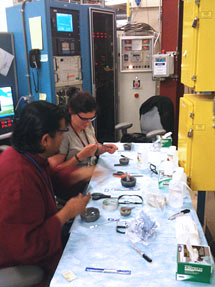From the Acting Director of SSRL:
A Successful 2010 User Run
by Piero Pianetta
It is that time of year again at the Stanford Synchrotron Radiation Lightsource when the SPEAR3 storage ring shuts down, the users pack up and go home to analyze their data, and the support staff gear up for a busy period of upgrades and much needed maintenance activities as well as some well-deserved rest.
At the risk of repeating my column from last year, 2010 has been a great year for SSRL operations. We ran for the first time in true top-off mode, in which the current was kept constant in SPEAR3 by
frequent (every 10 minute) injections. This mode of operation was approved for routine use only in June. The users have been extremely pleased with this operating mode—no more interruption of scans to wait for the injection to take place, and a 20 percent higher intensity since the beam is no longer allowed to decay for eight hours before filling. This mode of operation puts severe constraints on the reliability of all the SPEAR3 systems since the injector system must run continuously—any errors show up as a missed fill, which is evident on the beam current display. The occasional missed fill does not adversely affect the users. The goal of zero missed fills comes from a sense of pride from the operations staff and probably a few side-bets.
Read more...
Kids' Day Registration Ends Monday
by Julie Karceski
Deadline update: With SLAC Kids' Day rapidly approaching, registration will be closing on
Monday, August 2 at 10 a.m. Workshop A (hydrorockets)
for the 9-11 year-olds is filled, but space is open in other workshops.
Sign up
online. Reminder: if you have not paid Kids Day registration, you are not registered.
Since workshop A is filled, preference will be given to children whose registration is paid, then to those who did not attend workshop A last year.
Escorts are still needed. To volunteer, please sign up on the
Kids Day site.
 Summer school participants prepare samples for low-energy S K-edge X-ray Absorption Spectroscopy. (Photo courtesy Ritimukta Sarangi.) SSRL Summer School Shines a Light on Sulfur
by Kelen Tuttle
Nineteen graduate students, postdocs and researchers gathered at SLAC last week for the Stanford Synchrotron Radiation Lightsource
Structural Molecular Biology Low-Z XAS Summer School.
The first such SSRL summer school since the late 1990s, the workshop focused on a technique called low-energy X-ray Absorption Spectroscopy. When conducting XAS, a researcher aims an X-ray beam at a sample and tunes the beam through a range of energies. Specific chemical elements absorb specific energies, so when just the right energy beam hits the sample, atoms of a particular element will eject electrons, providing information about the atom's electronic structure. In particular, the workshop covered low-energy ranges (from 2.4 to 4 kilo-electronvolts) and the element sulfur, a technique called "S K-XAS."
Read more...
What are the chances of a universe like ours? (Image by Sandbox Studios.)
Word of the Week: Landscape
by Lori Ann White
Among theoretical physicists, the word "landscape" has taken on a meaning far beyond a scenic view or the subject of an oil painting. Their concept of the landscape encompasses all the myriad versions of the universe that not only can but, some say, do exist.
This conjuration of extra universes helps theorists address the idea that the unique circumstances of our existence are perhaps too unique. For example, if any of the four forces were slightly stronger or weaker—or even if the ratios between them changed—a universe in which we could exist would not form.
Hence the landscape of possible universes. If ours is only one of a multitude (10500 is the number usually mentioned), all of these "constants" of nature can indeed have other values, in other universes. Some of the universes are no doubt barren not only of life but of matter; some might be in the grip of strange chemistries that allow stars and planets but not our form of life.
But our universe, now—our universe is just right.
|




 <%
Response.AddHeader "Last-modified", getArticleDate()
'Response.AddHeader "Last-modified","Mon, 01 Sep 1997 01:03:33 GMT"
'Monday, December 06, 2010
%>
<%
Response.AddHeader "Last-modified", getArticleDate()
'Response.AddHeader "Last-modified","Mon, 01 Sep 1997 01:03:33 GMT"
'Monday, December 06, 2010
%>